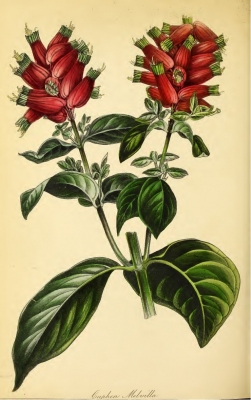Cuphea melvilla
Lindl.
Lythraceae
Cuphea elegans Klotzsch ex Koehne
Cuphea melvillei Lem.
Cuphea penicillaria Pohl ex Koehne
Cuphea speciosa (A.Anderson ex Raf.) Kuntze
Melvilla speciosa A.Anderson ex Raf.
Common Name:

Drawing of the flowering stem
Photograph by: Paxton's Magazine of Botany Vol. 8, 1841

General Information
Cuphea melvilla is an evergreen, much-branched perennial plant with stems that can become more or less woody and persist.
The plant is harvested from the wild for local use as a medicine. It is often grown as an ornamental in the tropics, and sometimes in heated greenhouses in the temperate zone.
Known Hazards
None known
Botanical References
Range
S. America - Argentina, Paraguay, Brazil, Peru, Ecuador, Venezuela, Guyana
Habitat
Rainforest, scrub and savannah; at elevations up to 500 metres.
Properties
| Medicinal Rating |      |
| Habit | Evergreen Perennial |
| Height | 0.00 m |
| Pollinators | Insects, Humming birds |
| Cultivation Status | Wild |
Cultivation Details
Species in this genus generally prefer a position in full sun, but are tolerant of partial shade. They generally grow best in average, medium moisture, well-drained soils[
352- Title
- KemperCentreForHomeGardeningPlantFinder
- Publication
-
- Author
-
- Website
- http://www.mobot.org/gardeninghelp/plantfinder/
- Publisher
- Missouri Botanical Garden
- Year
- 0
- ISBN
-
- Description
- Basic cultivation details, plant uses, habitat etc for several thousand species of plants, mainly from the temperate zone.
].
The seed of Cuphea species is generally a good source of medium length fatty acids, which have a range of industrial and cosmetic applications and can also be used in foods[
289- Title
- The National Non-Food Crops Centre Crop Database
- Publication
-
- Author
-
- Website
- http://www.nnfcc.co.uk/crops/pd.cfm
- Publisher
-
- Year
- 0
- ISBN
-
- Description
- An excellent on-line information source, with information on over 100 species (as of 2006) of plants being investigated as bio-crops.
]. Several species are being trialled as seed oil crops in temperate zone countries, though they are unlikely to become a commercial crop in the tropics simply because it is so much easier to grow oil crops such as palm oil (Elaeis species) and coconut (Cocos nucifera).
Edible Uses
None known
Medicinal
A decoction of the plant is used as a general cure-all. It is also considered to be an infallible cure for haemorrohids[
1209- Title
- A comprehensive review of Cuphea (Lythraceae)
- Publication
- Research Journal of Pharmaceutical, Biological and Chemical Sciences 2(3):847-855 · July 2011
- Author
- Mohamed R Elgindi; Nahla Ayoub; Rola Milad and Reham Hassan
- Publisher
-
- Year
- 2011
- ISBN
- 0975-8585
- Description
- Gives information on the traditional medicinal uses of various cuphea species, and also a review of modern research and the compounds the plants contain.
].
Other Uses
The seed contains around 46.2% lauric acid.
We have no further specific information for this species but, although rather small, the seed of Cuphea species is generally a good source of medium length fatty acids[
289- Title
- The National Non-Food Crops Centre Crop Database
- Publication
-
- Author
-
- Website
- http://www.nnfcc.co.uk/crops/pd.cfm
- Publisher
-
- Year
- 0
- ISBN
-
- Description
- An excellent on-line information source, with information on over 100 species (as of 2006) of plants being investigated as bio-crops.
].
Industrial oils made from these fatty acids have a range of uses, including as a defoaming agent; a booster for soaps and detergents; and in health and beauty products[
289- Title
- The National Non-Food Crops Centre Crop Database
- Publication
-
- Author
-
- Website
- http://www.nnfcc.co.uk/crops/pd.cfm
- Publisher
-
- Year
- 0
- ISBN
-
- Description
- An excellent on-line information source, with information on over 100 species (as of 2006) of plants being investigated as bio-crops.
]. They can also be used in foods, mostly as vegetable shortenings.
Propagation
Seed - can be sown in situ[
200- Title
- The New RHS Dictionary of Gardening. 1992.
- Publication
-
- Author
- Huxley. A.
- Publisher
- MacMillan Press
- Year
- 1992
- ISBN
- 0-333-47494-5
- Description
- Excellent and very comprehensive, though it contains a number of silly mistakes. Readable yet also very detailed.
]. Germination usually takes a few weeks because of the hard seed coat.
If you have any useful information about this plant, please leave a comment. Comments have to be approved before they are shown here.
 Useful Tropical Plants Database 2014 by
Ken Fern,
web interface by
Ajna Fern
with help from
Richard Morris.
Useful Tropical Plants Database 2014 by
Ken Fern,
web interface by
Ajna Fern
with help from
Richard Morris.